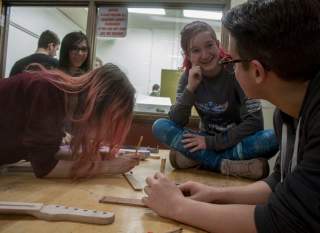Making Guitars For Science? Here's One Idea To Fix STEM Education
It makes more sense than you'd think.
The Big Idea:
I’m part of a team of professors and high school teachers around the country that encourages high schools to teach kids to build guitars as a way of making science, technology, engineering and math subjects, collectively known as STEM, more interesting. The STEM Guitar project brings high school teachers to weeklong workshops where they learn to make guitars so they can introduce the process to their students. They leave with their own guitars and all the teaching materials they need.
Over the past decade, we’ve taught more than 450 teachers from nearly every state who have, in turn, gotten more than 20,000 students to make guitars. The program is particularly active in California and Washington state.
Why it matters:
The demand among employers for workers with technical skills is large everywhere, including in the United States. Estimates vary, but experts are concerned that there could be a shortage of millions of these workers. However, traditional teaching methods are not working for many high school students, partly because many don’t see how they might use this knowledge as adults. Unlike science and math, engineering and technology skills aren’t typically included in the standardized tests used to evaluate students and their teachers. Because the stakes are high, schools generally make the subjects that are tested their highest priority.
When kids make guitars, they learn the math and science, but also the importance of mechanical precision, the design process and basic manufacturing skills, which are central to what engineers do.
For example, as they go through the different steps of building a guitar, they learn about the underlying physics. Electric guitars all have pickups, small devices that use something called electromagnetic induction to make sound, so they learn something about physics in these classes. And those little metal wires that go across the neck of a guitar, the frets, have to be arranged in a specific way. The way you figure out that arrangement requires algebra.
How I do my work:
We created a curriculum that teachers learn to deliver through five days of training in workshops held around the country. We supply teaching materials, a textbook and guitar kits that high school teachers can then use in their classes. Since the workshops run all day for a week, we hold them during the summer.
The teachers learn to make electric guitars from wood, following one of a few standard designs. Most electric guitars have solid wood structures and make music using electromagnetic pickups connected to amplifiers. Initially all students learned to make electric guitars. More recently, we have helped them learn to make acoustic guitars. These use the vibrations of their light wood structures to radiate sound directly and don’t need electronics. However, their construction and the underlying physics are more complicated.
We don’t have time to teach anyone how to play their instruments, though impromptu jam sessions often break out. Teachers can also point students toward some good online lessons we suggest.
Our project has also started working directly with veterans. Some vets need help in transitioning to life after the military. Some want to learn marketable skills and some just need the experience of succeeding at something challenging and interesting. We’ve just started this work, but veterans and the people supporting them have been enthusiastic so far. We are very pleased to have found a way to help them out.
What still isn’t known:
We don’t know how many schools are willing to try this unusual approach. Also, we’re excited that teachers are reporting their students are more engaged and some students even state they want to come to school so they can work on guitars. However, we don’t know how learning STEM by making guitars affects most people later on. While gathering this information would be difficult, it would help us refine our approach to make it more effective.
What’s next:
We are developing classes that will teach teens to make guitars with computer-controlled machines similar to the ones used by musical instrument and other manufacturers. Students will learn how to make their own parts and they can follow our designs or invent their own. At its best, engineering is fundamentally a creative process. So it’s important for students to move beyond manufacturing our designs to design their own instruments.
This article by Mark French, Professor of Mechanical Engineering Technology at Purdue University, first appeared in The Conversation in January 2020.
Image: James Cordero, CC BY-SA.

